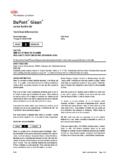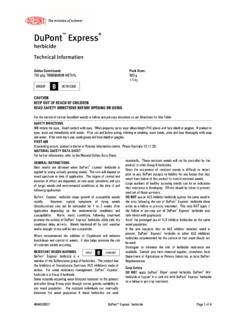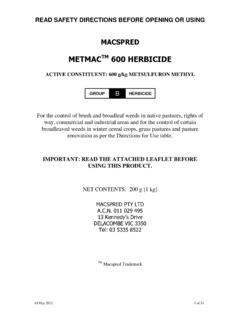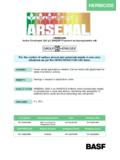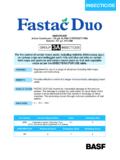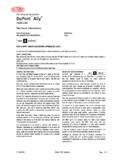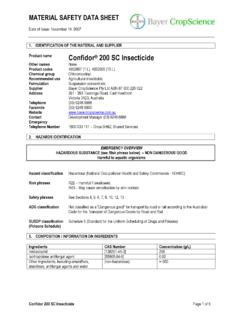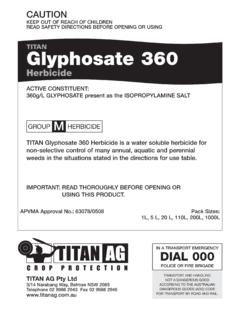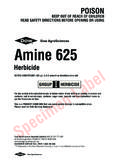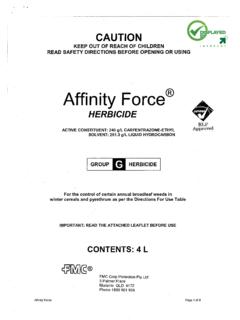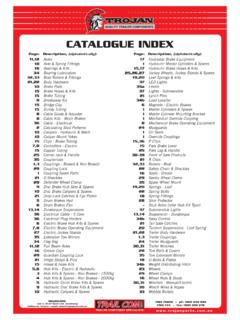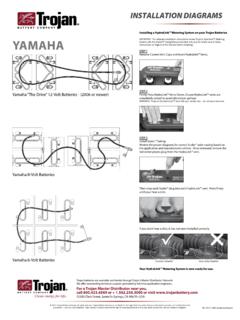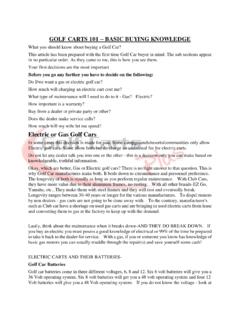Transcription of Trojan Insecticide label - HerbiGuide
1 Specimen LabelCAUTIONT rojan InsecticideACTIVE CONSTITUENT: 150 g/L GAMMA-CYHALOTHRINFor the control of certain insect pests in cotton, barley, wheat and various field crops as specified in the Directions For AgroSciences Australia Limited 24 003 771 65920 Rodborough Road FRENCHS FOREST NSW 2086 SERVICE TOLL FREE 1-800 700 096 Trademark of Dow AgroSciences Registered trademark Cheminova OUT OF REACH OF CHILDRENREAD SAFETY DIRECTIONS BEFORE OPENING OR USINGS pecimen LabelSpecimen LabelBRASSICA VEGETABLES:Broccoli, Brussels Sprouts, Cabbage, Cauliflower ONLYF orage brassicasCanolaDiamondback moth(Plutella xylostella),Cabbage white butterfly(Pieris rapae),Cabbage cluster caterpillar(Crocidolomia pavonana)Cabbage moth (Plutella xylostella) Cabbage white butterfly (Pleris rapae)Rutherglen bug and Grey cluster bug (Nysius spp.)All statesQld, NSW, NT, Tas, Vic & WANSW, Vic, Tas, SA & WA onlyNSW, Vic, Tas, SA & WA onlyApply at first sign of infestation.
2 For schedule spraying on a weekly basis, use the lower rate. For spraying as needed use the higher rate for longer persistence. Use a minimum of 500 L water/ha. Add a 100% concentrated non-ionic surfactant at 6 mL/100 L of spray as soon as larvae reach threshold numbers. Check with local officer of the Department of Agriculture for thresholds applicable to the particular growth stage of the only near maturity when severe infestations are likely to down-grade best results, apply at hatching or soon after. Use higher rate if the crop is dense or the larvae are larger than 10 mites are present on an establishing crop, apply at the first sign of crop emergence. Monitor the crop regularly for reinfestation and respray if or 30 mL plus surfactant20 mL30 mL20 or 30 mL8 mL* (see footnote)2 days harvest/grazing7 days harvest/grazingDIRECTIONS FOR USEFor ULV application: Trojan Insecticide can be mixed into mineral spraying oil for all uses except those indicated in the CRITICAL COMMENTS in the DIRECTIONS FOR USE table (Thrips tabaci)Native budworm(Helicoverpa punctigera)Redlegged earthmite(Halotydeus destructor)CEREALS: Barley, Wheat ONLYP asture webworm(Hednota spp.)
3 Vic, NSW, Tas, SA & WA only Pre-seeding - the product can be tank mixed with knock down herbicides. Post crop emergence - inspect crop regularly from sowing. Spray at first sign of damage. Use a minimum of 50 L water/ha. Apply at first sign of infestation before larvae are 10 mm mL14 days harvest/grazingPink or brown cutworm (Agrotis munda)All statesFor best results apply at first sign of infestation before larvae are 10 mm long. If larvae are larger than 10 mm use the higher rate. Use a minimum of 50 L or 15 mLCommon cutworm(Agrotis infusa)NSW onlyAphids (Rhopalosiphum spp.) (Barley yellow dwarf virus vectors)To control aphids, sprays should be applied at 4 and 8 weeks after emergence to reduce aphid colonisation and suppress Barley yellow dwarf virus. Use the higher rate when greater than 15 aphids on 50% of tillers is expected during the or 15 mLRedlegged earthmite(Halotydeus destructor)If mites are present on an establishing crop, apply at first sign of crop emergence.
4 Monitor crop regularly for reinfestation and respray if mL* (see footnote)Blackhead pasture cockchafer (Aphodius tasmaniae)NSW, Vic, Tas, SA & WA onlyTreat as soon as possible after the autumn rains stimulate egg hatching and activity of existing larvae. This can be ascertained by monitoring soil populations in known areas. For best results spray when the larvae have surfaced to feed after rain. Preferably use a boom spray delivering 70-100 L water/ha. Use the lower rate until early June and the higher rate after mid-late NOT USE ULV APPLICATION FOR THIS PEST17 or 35 mLCROPPEST CONTROLLEDSTATECRITICAL COMMENTSAPPLICATION RATE/HAWITHHOLDING PERIODS pecimen LabelSpecimen LabelCROPPEST CONTROLLEDSTATECRITICAL COMMENTSAPPLICATION RATE/HAWITHHOLDING PERIODCITRUS: Oranges, Lemons ONLYF uller s rose weevil(Asynonychus cervinus)All statesFirstly ensure that the trees are skirted and all weeds under the trees are removed.
5 Apply 250 mL of spray solution to the tree trunk at about 300 mm from the ground in a 100 mm band. Deliver the spray through a U shaped wand fitted with 4 nozzles evenly spaced around the tree. Trees must be treated in the early stages of the adult weevils emerging from the mL/100 L as a directed spray4 weeks harvestCottonNative budworm(Helicoverpa punctigera) Cotton bollworm(Helicoverpa armigera)Qld, NT, NSW & WA only70 mL60 mLPink-spotted bollworm (Pectinophora scutigera)NT & Qld Only60 mLGreen mirid(Creontiades dilutus) Brown mirid ( ) Apple dimpling bug(Campylomma liebknechti)Brokenbacked bug(Taylorilygus pallidulus)Cottonseed bug(Oxycarenus luctuosus) Pale cotton stainer (Dysdercus sidae) Leafhoppers (Austroasca viridigrisea & Amrasca terraereginae)Qld, NT, NSW & WA only50 mL21 days harvestApply when egg laying is light - less than 25 eggs/100 terminals and no larvae are mLApply when egg laying is heavy and continuous and/or when H.
6 Punctigera larvae are greater than 10 mm in length. For H. armigera, apply only to larvae less than 5 mm in length. For suspected resistant populations add the label rate of PBO synergist or mix with the label rates of when egg laying is moderate - greater than 25 eggs/100 terminals and/or when less than 12 newly hatched larvae/100 terminals are with the Helicoverpa program when used at this rate. If the Pink-spotted bollworm is the only pest present, apply when more than 10 adult moths are caught in pheromone traps on two consecutive at recommended threshold levels as indicated by field peasNative budworm(Helicoverpa punctigera)NSW, WA, Vic & SA onlyFor best results, apply at hatching or soon after. Use higher rate if the crop is dense or the larvae are larger than 10 or 30 mL7 days harvest/grazingPea weevil (Bruchus pisorum)NSW & SA onlyFollow State Department of Agriculture (South Australia only) guidelines for controlling pea weevil.
7 If these are unavailable, monitor the crops regularly once flowering commences and apply as soon as adult weevils are detected. Adults must be controlled before egg laying begins. Both native budworm and pea weevil populations can be easily monitored using a sweep net in the top section of the only: Commence monitoring the crop for Pea weevil presence using a sweep net, prior to flowering. Spray when one weevil per one hundred sweeps is found for milling grade seed, or one weevil per twenty-five sweeps for feed grade seed. Continue monitoring after spraying and respray if necessary. Use either a border spray (most cases) or whole crop spray, depending on pea weevil penetration of the mLVic & WA only30 mLSpecimen LabelSpecimen LabelCROPPEST CONTROLLEDSTATECRITICAL COMMENTSAPPLICATION RATE/HAWITHHOLDING PERIODR edlegged earthmite(Halotydeus destructor)NSW, Vic, Tas, SA & WA onlyIf mites are present on an establishing crop, apply at the first sign of crop emergence.
8 Monitor crop regularly for reinfestation and respray if necessary. Control of Lucerne flea will not be obtained with this mL* (see footnote)LucerneNative budworm (Helicoverpa punctigera)Lucerne leaf roller (Merophyas divulsana)All statesFor best results apply at hatching or soon after. Use higher rate if the crop is dense or the larvae are larger than 10 best results apply at hatching or soon after. Use higher rate if the crop is dense or the larvae are larger than 10 mm. Apply the first spray when about 30% of the terminals are or 30 mL14 days harvest/grazingPea aphid(Acyrthosiphon pisum)Good coverage, particularly the stems, is essential. Use hollow cone mLField peas7 days harvest/grazingBlackhead pasture cockchafer(Aphodius tasmaniae)NSW, Vic, Tas, SA & WA onlyTreat as soon as possible after the autumn rains stimulate egg hatching and activity of existing larvae. This can be ascertained by monitoring soil populations in known areas.
9 For best results spray when the larvae have surfaced to feed after rain. Preferably use a boom spray delivering 70-100 L water/ha. Use the lower rate until early June and the higher rate after mid-late NOT USE ULV APPLICATION FOR THIS PEST17 or 35 mLRedlegged earthmite(Halotydeus destructor)If mites are present on an establishing crop, apply at first sign of crop emergence. Monitor crop regularly for reinfestation and respray if necessary. Control of Lucerne flea will not be obtained with this mL* (see footnote)LupinsNative budworm (Helicoverpa punctigera)WA, SA, Vic & NSW onlyFor best results, apply at hatching or soon after when larvae are small. WA only: Environmental factors may cause populations of small caterpillars to decline, reducing damage potential, spraying should commence once caterpillars are 12 mm in mL14 days harvest/grazingBrown pasture looper (Ciampa arietaria)Redlegged earth mite (Halotydeus destructor)NSW, WA, SA, Vic & Tas onlyOnce crop has emerged, inspect regularly and apply at the first signs of damage.
10 Use a minimum of 50 L NOT USE ULV APPLICATION FOR THIS PESTIf mites are present on an establishing crop, apply at the first sign of crop emergence. Monitor crop regularly for reinfestation and respray if necessary. Control of Lucerne flea will not be obtained with mL8 mL* (see footnote)PasturePasture webworm(Hednota spp.)Vic, NSW, Tas, SA & WA onlyApply once larvae are present using adequate water to ensure good mL14 days harvest/grazingBrown pasture looper(Ciampa arietaria)All statesDO NOT USE ULV APPLICATION FOR THIS PESTPink or brown cutworm(Agrotis munda)For best results apply at the first sign of infestation before larvae are 10 mm long. If larvae are longer than 10 mm, use the higher rate in a minimum of 50 L or 15 mLCommon cutworm(Agrotis infusa)NSW onlyAll statesSpecimen LabelSpecimen LabelCROPPEST CONTROLLEDSTATECRITICAL COMMENTSAPPLICATION RATE/HAWITHHOLDING PERIODP otatoesVegetable leafhopper / Jassids(Austroasca viridigrisea)All statesApply only when numbers are mL7 days harvestBlackhead pasture cockchafer (Aphodius tasmaniae)NSW, Vic, Tas, SA & WA onlyTreat as soon as possible after the autumn rains stimulate egg hatching and activity of existing larvae.
